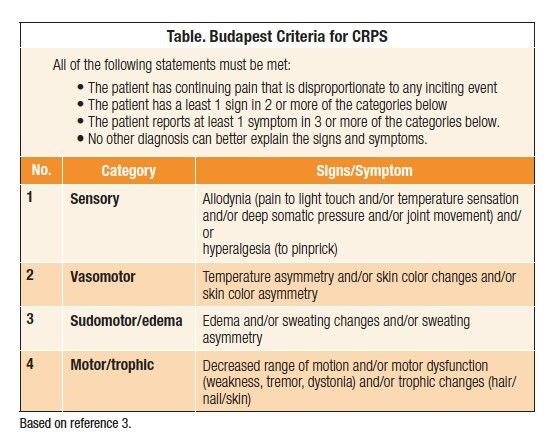CRPS
Complex regional pain syndrome (CRPS) is characterised by chronic regional pain with extreme tactile allodynia, plus a combination of other symptoms including vasomotor, sudomotor, and motor changes. The changes are disproportionate to the inciting event.
Definition
The IASP defines CRPS as a “syndrome characterized by a continuing (spontaneous and/or evoked) regional pain that is seemingly disproportionate in time or degree to the usual course of pain after trauma or other lesion. The pain is regional (not in a specific nerve territory or dermatome) and usually has a distal predominance of abnormal sensory, motor, sudomotor, vasomotor edema, and/or trophic findings. The syndrome shows variable progression over time.”
Characteristics
There are two subtypes of CRPS.
CRPS I (Reflex Sympathetic Dystrophy)
This was previously known as reflex sympathetic dystrophy. There is no precipitating nerve injury. In two thirds of cases the precipitating event is trauma to a distal part of an extremity, particularly fractures, post-surgical states, and sprains. Less common precipitating events are spinal cord injuries, CVAs, head injuries, abdominal disease, and myocardial infarction. Idiopathic cases can occur where it arises following minor trauma that isn't remembered by the patient.
There is asymmetric distal extremity pain and swelling with no demonstrable peripheral nerve injury. Patients often describe spontaneous burning pain in the affected region. The pain is severe and disproportionate to the severity of the inciting event. The pain tends to increase in dependent positions.
As well as spontaneous pain, there is also severe stimulus-evoked pain that often appears early. This includes mechanical and thermal allodynia and/or hyperalgesia. Deep somatic allodynia can occur which is pain with movement and pressure on the joints.
There may be autonomic changes with swelling and alterations in sweating and blood flow to the skin. Acutely the affected region tends to be warmer than the contralateral unaffected region. Sweating abnormalities are almost universal being generally hyperhidrosis, but hypohidrosis can also occur.
Trophic changes include abnormal nail growth, increased or decreased hair growth, fibrosis, thin glossy skin. In chronic stages osteoporosis can occur. Passive joint restriction can occur due to functional motor changes and trophic joint and tendon changes. Weakness is often present, and fine motor skills are particularly impaired. Dystonia occurs in about 10% of cases.
CRPS II (Causalgia)
This was previously known as causalgia. There is a history of injury to a major peripheral nerve. The clinical features are similar to CRPS I. The key difference is that there is evidence of injury to a major peripheral nerve. However the symptoms and signs can (but not always) spread beyond the innervation of the peripheral nerve.
Diagnosis
Budapest Criteria
Management
Principles
The four pillars of management :
- Patient information and education to support self-management.
- Pain relief (medication and procedures).
- Psychosocial and behavioural management.
- Physical and vocational rehabilitation ( and activities of daily living and societal participation) .
A coordinated Multidisciplinary Program should therefore involve:
- Education
- Medical
- Physiotherapy and OT
- Psychological and Behavioural
- Societal and Vocational
Vocational and litigation support may be provided by specialist rehabilitation teams and, in other cases, these services are integrated into the regional pain management programme
- Active engagement of the patient/family in goal setting, goal review
- Control
- the patient remains responsible for their own rate of progress.
- Understanding and insight:
- how emotional stress, muscle tension and de-conditioning can increase pain experience.
- how their own behaviours may serve to exacerbate pain experience.
- Learning:
- self-management approach, including goal setting and pacing.
- the right balance between doing too much and too little.
- relaxation techniques, breathing exercises etc to reverse sympathetic arousal.
- Empowering the family:
- encouraging individual to keep active
Medical Management
Investigation and confirmation of diagnosis:
- Pharmacological intervention (in conjunction with pain team wherever appropriate) to provide a window of pain relief.
- Reassurance that physical and occupational therapy are safe and appropriate.
- Provide medical follow-up to prevent iatrogenic damage through inappropriate referral.
- Support any litigation/compensation claim to its resolution and conclusion.(if desired and appropriate).
Psychosocial and Behavioural management
- Identify any psychological factors contributing to pain and disability.
- Treat anxiety and depression.
- Identify, explore and proactively address any internal factors (eg counter-productive behaviour patterns)or external influences (eg. perverse incentives, family dynamics etc) which may perpetuate disability/dependency.
- Consider needs of family/carers – provide psychological intervention/counselling where appropriate.
- Provide a practical problem-solving, goal-orientated approach (involving both the patient and their family) to reduce barriers and promote healthy functioning.
Physical management
Retrain normal body posture.
- Desensitisation – handling the affected part followed by passive stretching/isometric exercise.
- Progression to active isotonic exercise and then strength training.
- General body re-conditioning – cardiovascular fitness.
- Encourage recreational physical exercise and functional goals.
- Techniques to address altered perception and awareness of the limb, eg. mirror visual feedback training or graded motor imagery.
Activities of daily living and societal participation
- Support graded return to independence in activities of daily living with clear functional goals.
- Assessment and provision of appropriate specialist equipment/adaptations to support independence.
- Removal of inappropriate/unnecessary equipment.
- Adaptation of environment.
- Extend social and recreational activities in and outside the home.
- Workplace assessment/vocational re-training.
Videos
Article Downloads
Media:Harden2010_-_Budapest_Criteria.pdf
References
Literature Review
- Reviews from the last 7 years: review articles, free review articles, systematic reviews, meta-analyses, NCBI Bookshelf
- Articles from all years: PubMed search, Google Scholar search.
- TRIP Database: clinical publications about evidence-based medicine.
- Other Wikis: Radiopaedia, Wikipedia Search, Wikipedia I Feel Lucky, Orthobullets,



